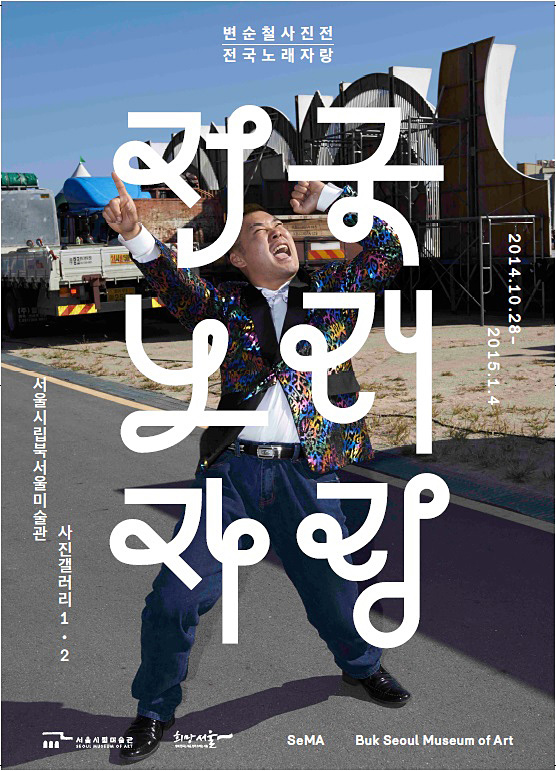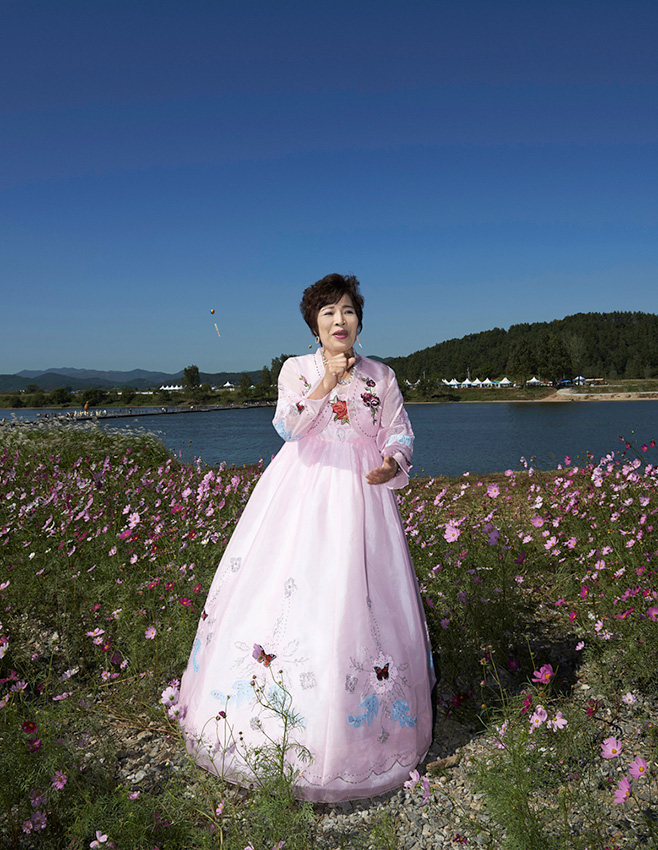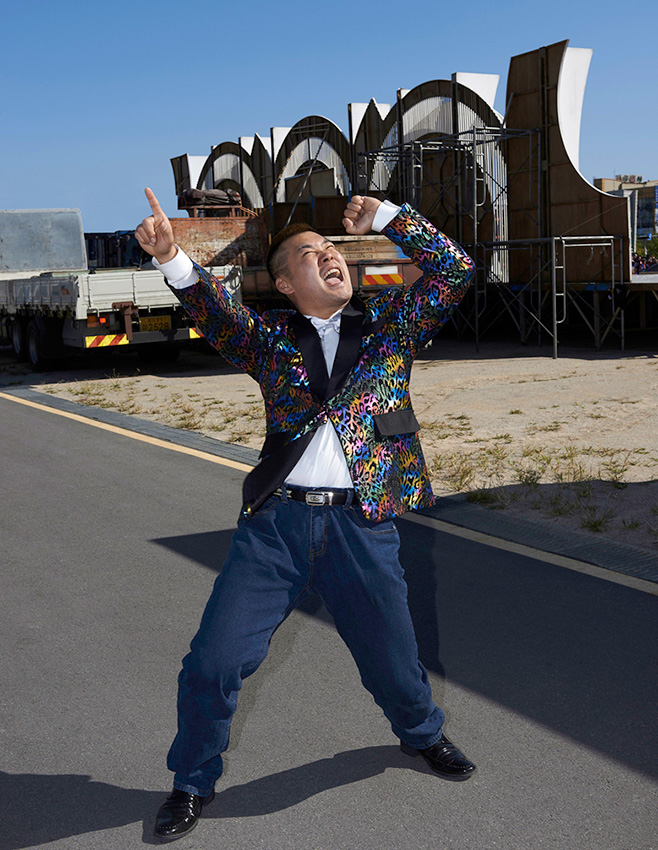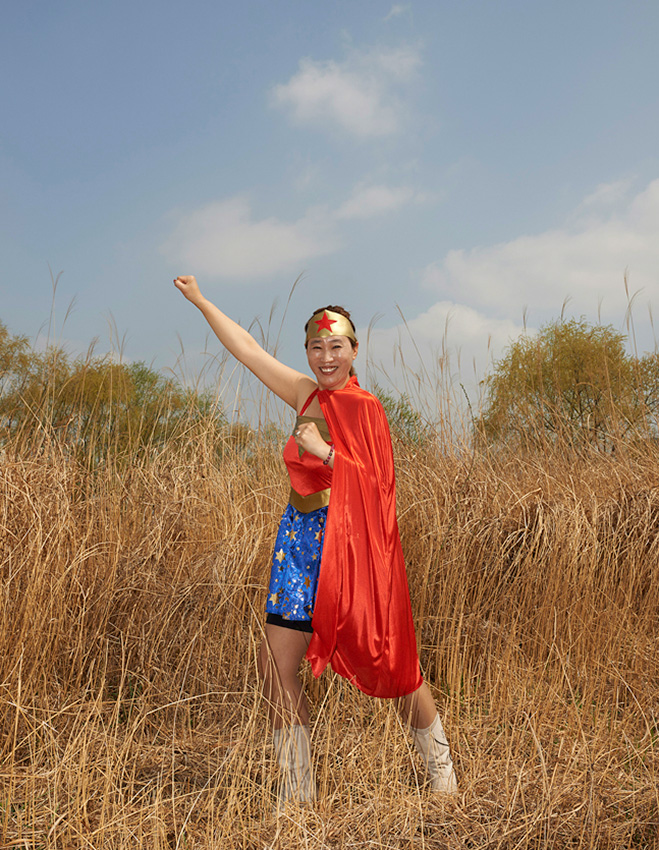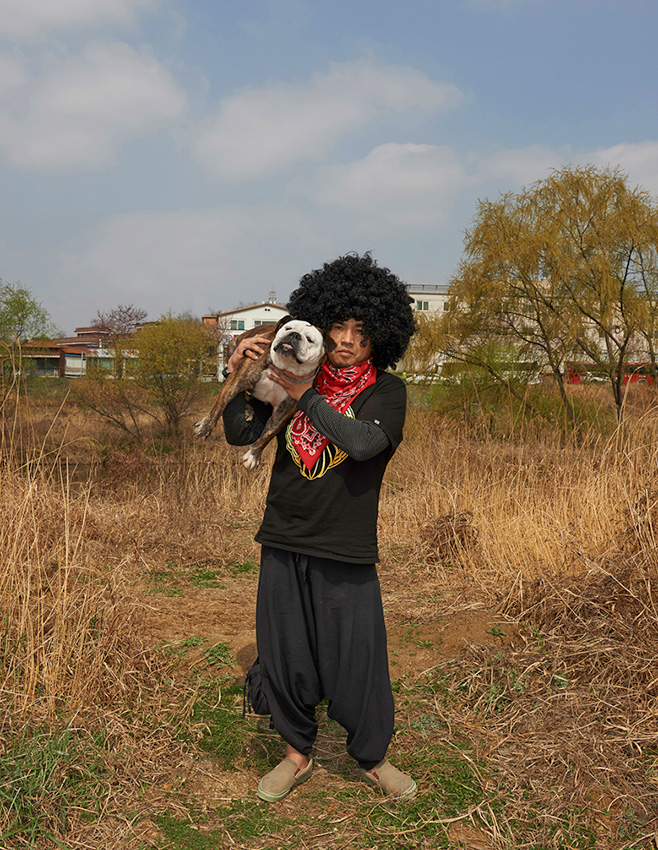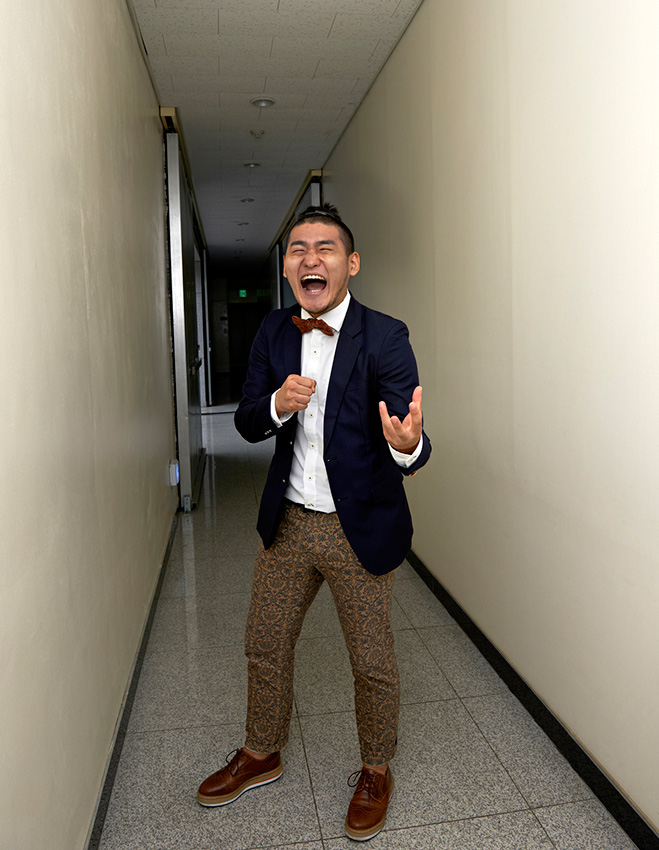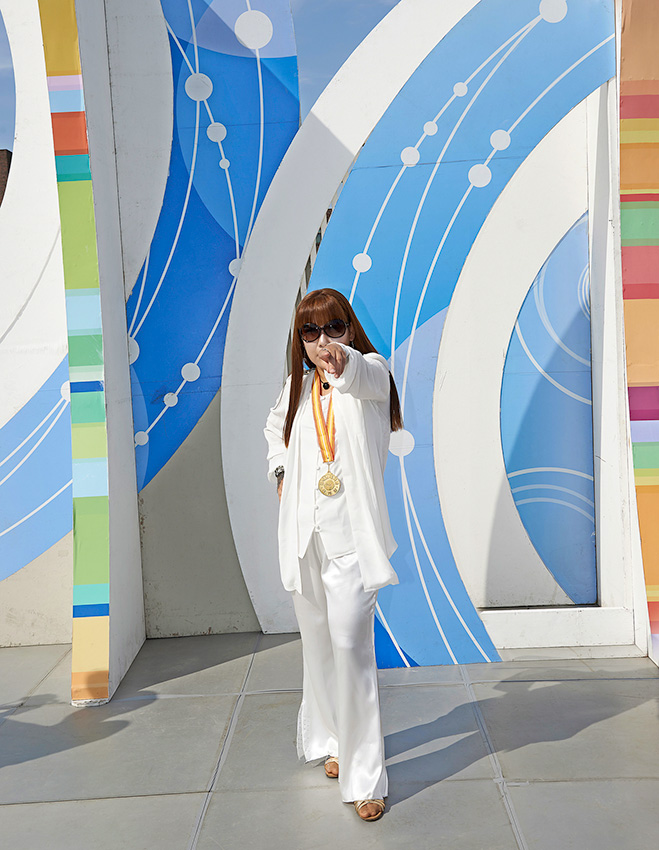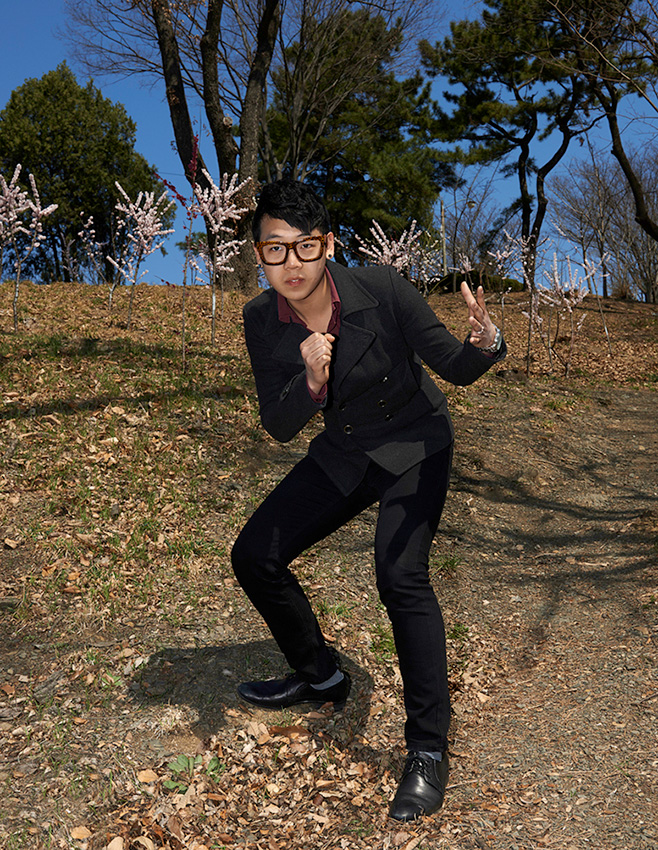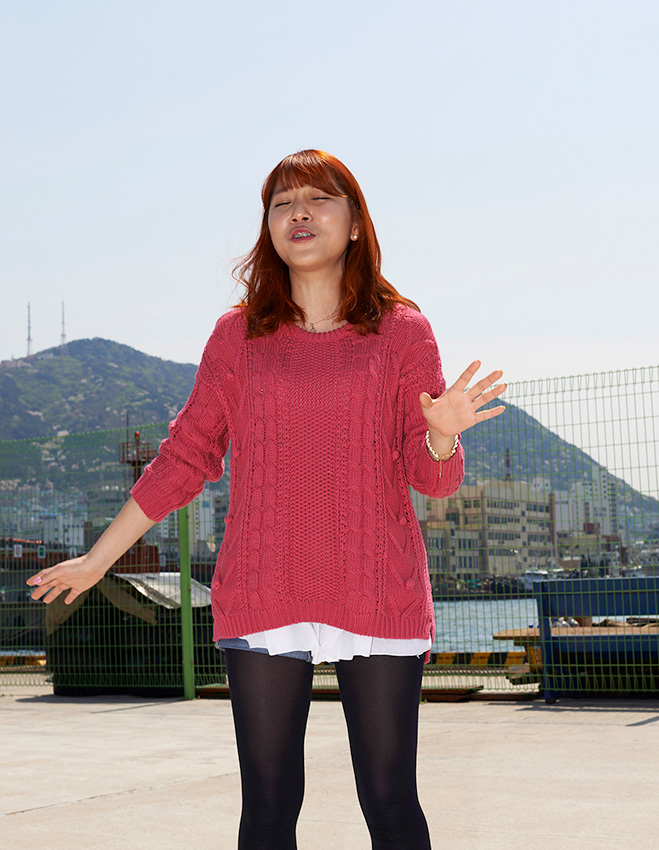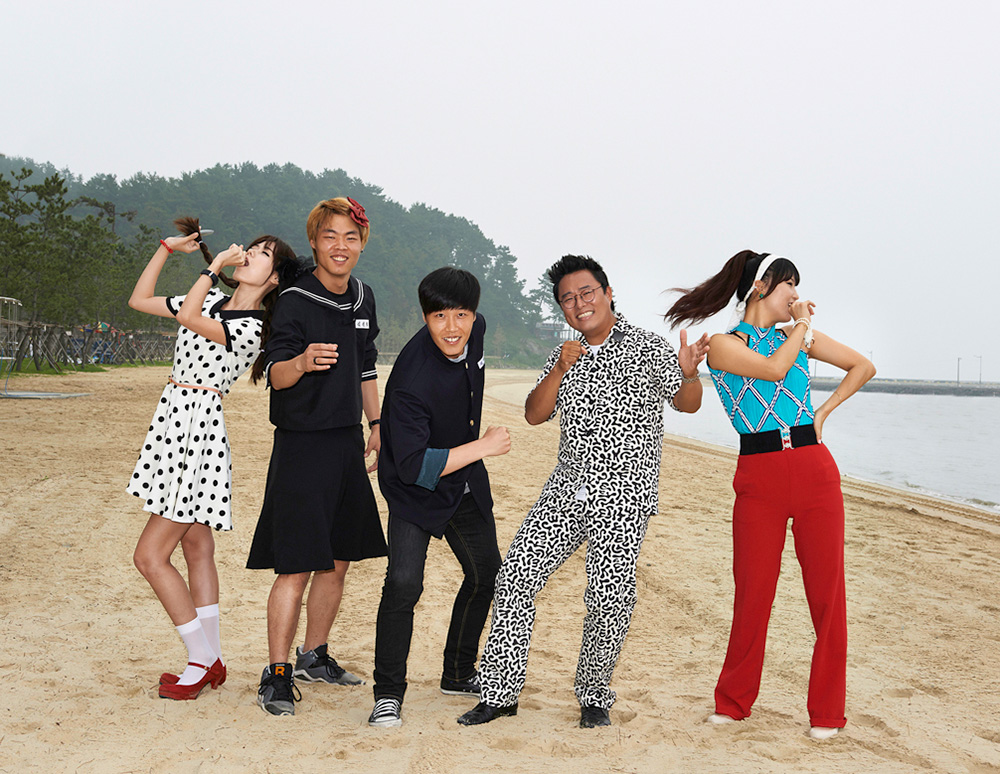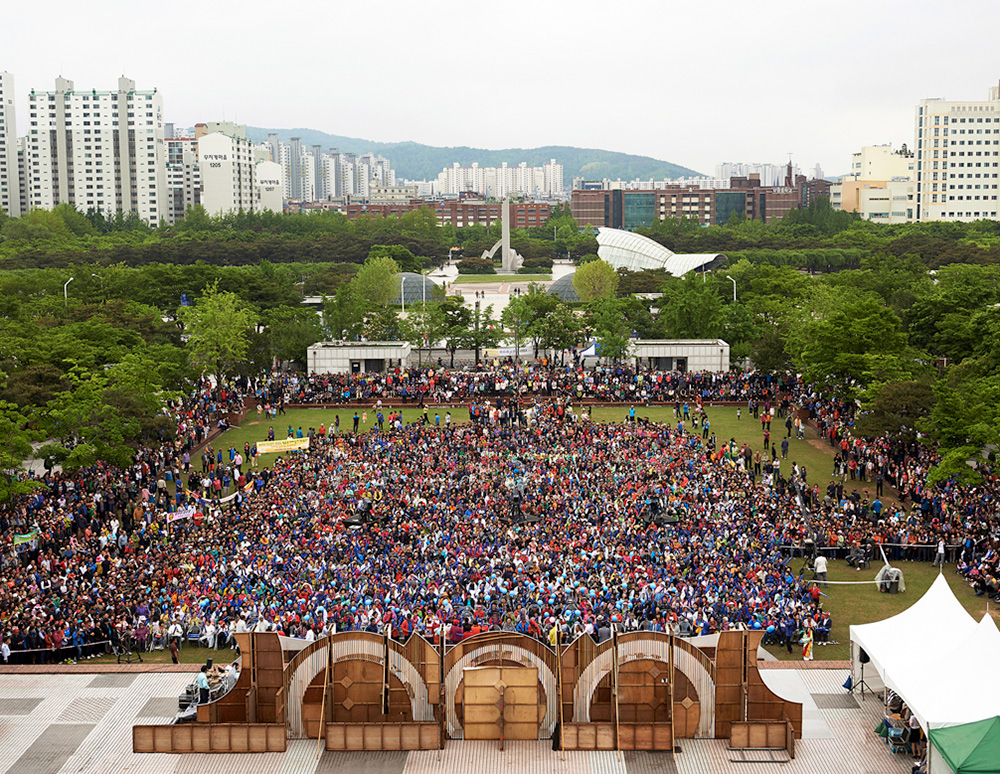서울시립 북서울미술관은 변순철 사진전 <전국노래자랑>을 개최한다.
사진을 통해 드러나는 삶의 보편성에 주목해 온 변순철은 KBS 전국노래자랑 녹화현장에서 만난 다양한 사람들을 촬영한 사진을 통해 인물의 평범함 속에 가려진 특별함을 포착한 초상사진을 선보인다.
KBS 1TV ‘전국노래자랑’은 1980년 첫 방송을 시작으로 30여 년 동안 많은 사람들의 사랑을 받아온 장수 프로그램이다. 오랜 시간동안 초상 작업을 진행해 온 작가는 2005년 ‘전국노래자랑’ 프로젝트를 시작하여 2012년부터 2014년까지 최근 3년간 본격적으로 작업을 진행하였다. ‘개인의 정체성은 사회와의 관계와 밀접한 연관이 있다’고 말하는 작가는 방송 출연자들이 노래자랑 프로그램에서 분출하려 했던 욕망을 사진을 통해 드러내며 동시대를 살아가는 다양한 세대의 ‘민낯’을 보여주고 있다.
작가가 바라보는 동시대 인물들에 대한 일종의 ‘심리적 연구서’라 할 수 있는 ‘전국노래자랑’ 프로젝트에는 ‘포장되고 가공되는 것이 아름다움의 기준이 아니라 오히려 날 것 같은 모습이 현 시대를 반영하는 온도계 일 수 있다‘는 작가의 생각이 깊이 반영되어 있다. 각 지방 사람들의 개성 넘치는 화려한 모습에서 비롯되는 생경함, 낯선 감정들을 사진 속 인물들의 얼굴표정과 자세를 통해 각 인물들이 지니고 있는 내면의 특별함을 이끌어 낸다.
사진갤러리 1, 2에서 펼쳐지는 본 전시에서는 ‘전국노래자랑’ 프로젝트와 함께 마련된 아카이브 자료와 영상을 통해 인물의 성별, 출신을 넘어서는 그들의 심리적 욕망을 직관적으로 포착하려 했던 작가의 의도를 발견할 수 있다. 나이나 성별의 제약 없이 모두가 동등한 위치에서 내면의 개성을 드러낼 수 있는 장(場)에서 작가가 발견한 평범한 인물속의 비범함을 함께 바라보며 우리 내면의 새로운 모습 또한 발견할 수 있는 기회가 되기를 기대한다.
KBS 1TV ‘전국노래자랑’은 1980년 첫 방송을 시작으로 30여 년 동안 많은 사람들의 사랑을 받아온 장수 프로그램이다. 오랜 시간동안 초상 작업을 진행해 온 작가는 2005년 ‘전국노래자랑’ 프로젝트를 시작하여 2012년부터 2014년까지 최근 3년간 본격적으로 작업을 진행하였다. ‘개인의 정체성은 사회와의 관계와 밀접한 연관이 있다’고 말하는 작가는 방송 출연자들이 노래자랑 프로그램에서 분출하려 했던 욕망을 사진을 통해 드러내며 동시대를 살아가는 다양한 세대의 ‘민낯’을 보여주고 있다.
작가가 바라보는 동시대 인물들에 대한 일종의 ‘심리적 연구서’라 할 수 있는 ‘전국노래자랑’ 프로젝트에는 ‘포장되고 가공되는 것이 아름다움의 기준이 아니라 오히려 날 것 같은 모습이 현 시대를 반영하는 온도계 일 수 있다‘는 작가의 생각이 깊이 반영되어 있다. 각 지방 사람들의 개성 넘치는 화려한 모습에서 비롯되는 생경함, 낯선 감정들을 사진 속 인물들의 얼굴표정과 자세를 통해 각 인물들이 지니고 있는 내면의 특별함을 이끌어 낸다.
사진갤러리 1, 2에서 펼쳐지는 본 전시에서는 ‘전국노래자랑’ 프로젝트와 함께 마련된 아카이브 자료와 영상을 통해 인물의 성별, 출신을 넘어서는 그들의 심리적 욕망을 직관적으로 포착하려 했던 작가의 의도를 발견할 수 있다. 나이나 성별의 제약 없이 모두가 동등한 위치에서 내면의 개성을 드러낼 수 있는 장(場)에서 작가가 발견한 평범한 인물속의 비범함을 함께 바라보며 우리 내면의 새로운 모습 또한 발견할 수 있는 기회가 되기를 기대한다.
과장된 해방구에서
소외와 역설을 읽는다
인물 사진은 고정된 인기를 누린다. 사진기가 고안된 긴 역사와 나란히 할 만큼 인물 사진의 수요도 지속적이었다. 피사체가 유명인사라면 수요는 당연히 급등한다. 근대 이전 나다르가 촬영한 문필가와 예술인 초상이 그 효시쯤 되리라. 2차 세계대전 후 정·재계의 거물급 인사를 두루 촬영한 유섭 카쉬의 초상 연작은 인물 사진 인기의 고전으로 기억된다. 필립 할스만은 한발 더 나아가, 점프를 하도록 요청하여 명망가들의 비일상적인 모습까지 연출하면서 독보적인 인물 사진의 경지를 마련했다. 스타의 얼굴값으로 유지되는 대중문화 시대가 되자, 유명 인사의 인물 사진은 견고한 장르가 되었다. 애니 레보비츠와 데이비드 라샤펠이 예능계 셀러브리티를 과대 포장된 스타 이미지로 재현하면서 동시대 관객의 기대감을 충족시켰다. 유명 인사를 촬영한 사진 전시회는 스테디셀러를 보장하는 전형적인 블록버스터로 자리를 굳혔다. 비단 유명 인사의 사진만이 고유한 인물사진 장르를 보유하는 건 아니다. 신디 셔먼을 유명하게 만든 원점은, 다양한 의상과 배역을 떠맡았던 무명시절의 자신을 촬영한 [무제 필름 스틸] 시리즈였다. 이탈리아 네오리얼리즘 계열 영화를 연상시키는 세트 속에서 신디 셔먼이 연기한 여성은 현대 산업사회에서 여성의 역할에 대한 의문을 제기했었다. 고정된 수요를 보장하는 유명인 사진이나 영화의 한 장면을 차용한 신디 셔먼의 연출 사진은 그렇다손 치고, 진부할 만큼 평범한 인물 사진의 계보는 어떻게 봐야할까? 다이안 아버스의 피사체는 평범한 인물이지만, 난장이, 거인, 장애인처럼 주변부를 맴도는 인물에 초점을 맞춰 변별력을 유지했다. 보통 사람의 모습을 통해 시대상을 주목하게 만든 인물 사진들도 있다. 대공황의 경제 불안정을 서민의 표정에서 읽어낸 워커 에반스의 사진이 그렇다. 또 [우리 시대의 초상 Antlitz der Zeit](1929)에서 직업군을 유형별로 구분시켜 사진의 고증적 가치를 발견한 아우구스트 잔더의 인물 사진도 비슷한 공로가 있다. 그렇지만 당대 보통 사람을 촬영한 이 다큐멘터리 사진들은 다큐멘터리 본령에 충실했기보다, 사진가의 연출을 통해 주제를 부각시킨 경우에 가깝다.
무수한 인물의 전신상을 담았으되, 변순철의 「전국노래자랑National Singing Contest」이 내국인에게는 그저 익숙한 한 장면일지도 모른다. 비록 도전자들의 과장된 표정과 몸짓에서 익살맞은 재미를 느낄 진 모르나, 노래경연대회에서 아마추어 도전자들이 구사하는 언어에 내국인들은 충분히 숙달되어 있다. 전국노래자랑은 1980년에 첫 방송을 탄 이래 우리나라 방송 역사상 최초로 단일 방송으로 30년 이상의 롱런을 기록했고, 음악 프로그램 전체를 통틀어 시청률 1위를 기록하며 꾸준한 사랑을 받는 프로그램이 되었다. 그래서 변순철의 사진 프로젝트 「전국노래자랑」이 포착한 도전자들의 익살맞은 포즈는 내국인에게는 낯익은 방송 영상을 스틸 컷으로 옮긴 정도로 수용될 여지가 크다. 공동체의 운명과 긴 세월을 함께 한 나머지, 외국인이 볼 때는 충분히 괴이하고 이국적인 광경조차 내국인의 시선에선 정상적으로 수용되는 건 [전국노래자랑] 외에도 더 있다. 서구에선 한철 지난 주거양식인 아파트가 한국에선 중산층의 상징적 건축양식으로 자리잡은 것도 한 예일 테고, 국적불명의 조악한 디자인을 뒤집어쓴 예식장 외관도 서구인의 시선에선 납득하기 힘든 문화 현상일 것이다. 이런 건물 안에서 한국의 커플 상당수가 자신의 혼례를 치른다.
공중파 방송 [전국노래자랑]은 한국인의 보편 취미가 문화현상으로 발현된 경우이다. 그렇지 않고서야, 고정된 시청자의 지지를 받아 무려 34년간 스테디셀러 방송으로 장수를 누리긴 어려울 것 아닌가. 급기야 동명의 극영화까지 제작 되는 단계에 이르렀다. 아마추어를 대상으로 하는 노래 경연대회가 전 세계에 설마 한국에만 존재할 턱은 만무하다. 그러나 전국 각지를 누비면서 지역 도전자들의 경합, 현지 관객의 열광, 모니터를 바라보는 전국 각지의 지지를 34년간 유지하는 노래 경연대회는 필경 한국이 유일무이하지 싶다. [전국노래자랑]에 도전장을 던진 아마추어들의 과장된 자기 과시는, 역설적으로 그 방송의 언어에 충분히 숙달된 내국인에게는 신비의 요소가 적다. 변순철의 사진 프로젝트 「전국노래자랑」이 내국인에 비해 외국인에게 훨씬 큰 호소력을 발휘하리라 추측 되는 이유다. 외국인에게 변순철의 [전국노래자랑]은 괴이하고 이국적인 동아시아 어느 나라의 문화 현상에 대한 기록물로 감상될 것 같다.
2005년에 처음 사진작업을 시작한 변순철의 「전국노래자랑」은 2006년, 2007년 연이어 추진되었고, 2012년부터 2014년까지 3년의 기록을 담은 이번 개인전까지 중장기 프로젝트로 진행되었다. 사진 프로젝트 「전국노래자랑」은 한국의 아마추어 노래경연대회에 참가한 도전자들의 무대 밖 모습에 집중한다. 짬을 내서 대기실 밖으로 나온 도전자들은 자기 기량을 과시하기 위해 다듬어지지 않은 과잉된 감정의 연기를 선보인다. 아울러 경연대회 주변으로 몰려든 관객을 담은 화면도 있다. 화면에 담긴 도전자들의 수는 많지만, 독보적인 미모를 가졌거나 시선을 사로잡는 포즈의 도전자는 찾기 어렵다. 이들의 포즈는 하나같이 ‘전국노래자랑 도전자 스타일의 제스처’로 통일되어 있다. 사진 속에는 유명인사의 모습은 당연히 찾을 수 없다. 그렇다면 전국을 순회하는 이 노래경연 방송을 다룬 사진 프로젝트의 관전 포인트는 무얼까?
크게 두 가지인 것 같다.
하나는 우리에겐 충분히 친숙한 아파트라는 주거문화와 예식장이라는 혼례 문화가 외국인의 시선에선 태생과 외관 모두에서 비정상성과 천박성을 띨 수밖에 없음에도, 한국 건축문화의 고유한 현상임을 부인할 수 없다. 마찬가지로 공중파 방송 [전국노래자랑]에 참여하는 아마추어 도전자들의 질박한 코믹 연기와 판에 박힌 연출은, 현지인의 전폭적인 지지와 방송의 롱런 때문에, 막상 현지인은 역설적으로 자각하지 못하는 부분이 많다. 그 부분이 외부인의 시각에선 괴이하고 이국적인 한국의 문화현상으로 느껴질 것이다. 사진 프로젝트 「전국노래자랑」은 거리두기를 통해 현지 문화를 기록하는 데 있다.
또 다른 관전 포인트는 피사체로서 관음 가치를 보장 못하는 경연대회 아마추어 도전자들의 인물 초상을 어떻게 봐야할 것이냐이다. 그들은 일반적으로 관객의 관음증을 충족시키는 유명인사도 아니다. 때문에 「전국노래자랑」의 인물 사진은 관객의 관음 욕구 충족이 아니라, 불특정 일반인 도전자들이 평소에 숨겨뒀던 과시 욕구를 발현시키는데 목적이 있다. 그들의 미숙련된 과시 욕구는 예외 없이 허황된 표현주의로 발현되고야 만다. 도전자들이 예외 없이 자기 과시를 위해 사용하는 신파조 표정과 몸짓은 필시 대중매체에서 본 프로 연기자들의 모습을 어줍지 않게 흉내 낸 결과일 것이다. 때문에 이들의 미숙한 감정 연기는 역설적으로 스스로를 대중매체의 객체임을 부각하는 꼴이 된다. 또한 도전자들의 신파조 연기는 관객과 시청자의 가벼운 웃음을 얻는 요인이라서 방송사가 원하는 바이기도 하다.
동일한 아마추어 노래경연대회임에도 서구식 모델인 [아메리칸 아이돌]을 벤치마킹한 [슈퍼스타K]나 [스타 오디션 위대한 탄생] 같은 대국민 공개 오디션 프로그램 등이 토종 [전국노래자랑]과 갈라지는 지점도 거기에 있다. 주류 진입을 위한 방송 등용문으로 소개되는 [슈퍼스타K]는 리얼리티 방송을 내세우지만, 정작 촬영 분량 가운데 감각적인 대사와 표정연기에 편향된 편집을 통해 리얼리티를 충분히 훼손하며, 도전자 스스로도 오버 액션의 자기주문을 거는 것 같다. 반면 [전국노래자랑]의 도전자나, 그것을 보는 시청자들은 이 방송을 주류 진입을 위한 발판으로 간주하지 않기 때문에 작위적인 드라마를 방송이 연출할 필요도 없고, 도전자의 남다른 기량을 부각시킬 이유도 없다. 도전자들이 신파조 코미디에 자발적으로 참여하는 것도 그 때문일 것이다.
무대에 오르기 전, 도전자들의 자기 존재감을 호소하는 사진들을 묶은 변순철의 「전국노래자랑」을 보자. 질 낮은 무대의상마저 처음 차려입었을 법한 일반인 도전자들의 전신상에서 의상과 인체 사이의 부조화가 도드라진다. 최소한의 시선을 잡아끌려고 머슴 의상, 슈퍼맨 의상, 구식 교복과 무술 복장 따위를 차려입고 서 있다. 이들의 복장은 한시적인 눈요기가 될 뿐, 이들이 동원할 수 있는 쇼맨십의 한계를 역설적으로 부각시키고야 만다.
이처럼 노래경연방송 [전국노래자랑]은 주류 가요계 진입을 위한 치열한 등용문이 아닌, 평범한 생활 리듬에서 일회적으로 탈출하기 위한 일반인의 해방구에 방점을 둔 지역 축제이다. 변순철의 경연대회 도전자 인물상이 관객의 관람보다 도전자 개인의 해방구에 방점을 둔 이유도 같은 맥락이다. 미숙한 신파조 쇼맨십이 전국 모든 지역 도전자들에게서 반복되는 이유도 그 때문이리라. 프로 매니저의 숙련된 관리가 닿지 않아서 때 묻지 않은 주변부 문화의 기록, 그것이 한국의 전국 시청자가 34년간 지지한 어느 가요경연대회를 기록한 사진 프로젝트 「전국노래자랑」의 진면모일 것이다.
「전국노래자랑」과 적당한 대비를 이룰 변순철의 전작으로 「짝-패Interracial Couple」를 꼽을 수 있다. 두 작품의 다른 점을 꼽자면 「전국노래자랑」이 아마도 국외 논평자에게 호소력이 클 거라 짐작되는 반면, 「짝-패」는 국내 논평자에게 훨씬 호소력이 클 것 같다. 선호도 여부를 떠나 두 연작은 부인할 수 없는 접점을 여럿 공유한다. 「짝-패」에 초대된 커플 가운데 명사는 없다. 더불어 시선을 사로잡을 이목구비의 연인조차 찾기 힘들다. 욕실 안에서 육중한 나체 백인 여성을 번쩍 떠안은 흑인 남성의 사진이나, 깡마른 동아시아 남성과 가슴이 과도하게 발달한 백인 여성이 서로 상의를 탈의하고 선 모습 정도가 그나마 기억에 남는 정도다. 「전국노래자랑」의 도전자 초상처럼 관음 가치가 높지 않은 인물 초상 연작이란 얘기이다. 또 마찬가지 이유로 「전국노래자랑」처럼 관람객의 관음 욕구를 배려하기보다, 피사체가 된 무명 커플들의 숨겨진 자기과시의 해방구에 비중을 둔 촬영 프로젝트로 보인다. 「짝-패」가 인종이 다른 커플들을 모아놓은 모양새이긴 하지만, 다인종 커플은 거스를 수 없는 메트로폴리탄적 현상이므로 큰 변별점을 이룰 것 같진 않다. 정리하면 「전국노래자랑」과 「짝-패」는 주변부의 무명 인사들에게 드물게 주어지는 자기 현시의 순간을 기록하고 있다.
관음적 호기심을 기대하기 힘든 평범한 커플들은 촬영자 변순철의 제안에 주저 없이 옷을 벗거나, 작가의 제안과는 무관하게 오히려 자발적으로 상의를 벗은 채 카메라 앞에 섰다. 「전국노래자랑」이 불특정한 일반 시민의 가슴 속에 똬리 튼 과시욕구와 자기 존재감의 확인을 위한 해방구였다면, 「짝-패」의 관전 포인트 역시 인종이 다른 두 남녀의 결합에만 그치지는 않을 것이다. 변순철의 모델 제안은 여러 커플들에게 자신을 주목하게 만드는 매우 희소하고 특별한 순간이었을 것이다. 이들은 태연한 척 카메라 앞에 포즈를 취했을지도 모르지만 자못 극적인 표정과 마음가짐으로 카메라 앞에서 섰을 것이다. 왜냐하면 어쩌면 평생 딱 한 번 주어지는 특별한 순간을 박제하기 위해 평소보다 자신을 관음적 대상으로 의식한 채 카메라 앞에서 포즈를 취했을지도 모른다. 아니, 그랬을 것이다.
「전국노래자랑」과 「짝-패」를 묶는 또 다른 교집합은 보통 사람의 초상만큼이나 단조로운 표제 달기이다. 「짝-패」에 속한 여러 커플들은 그저 [짝-패]라는 동일한 제목으로 분류되고 만다. 「전국노래자랑」은 방송사가 방문한 지명과 방문 연도만 기계적인 나열해서 제목으로 쓴다. 과장스런 표정과 표현주의적 제스처로 자기를 알리려는 노래 경연대회 도전자들이나, 평생 한 번 있을까 말까한 자기 과시의 기회에 주저 없이 옷을 벗고 카메라 앞에 선 일반인 커플의 비일반적인 포즈들이 모두 단조로운 표제 아래 조용히 분류되고 만다. 사진에 담긴 무수한 무명인들의 과장된 자기 과시를 단순한 표제가 허망하게 삼켜버리면서, 인간 존재의 허장성세와 인생의 소외까지 우연히 환기하게 만든다.
「전국노래자랑」과 「짝-패」를 묶는 또 다른 연결점은, 일반인의 특별한 순간을 관찰한 변순철의 사진이 다큐멘터리에 속할 게 분명함에도 다큐멘터리 본령에 충실하기보다, 사진가의 연출에 비중을 둔 리얼리티라는 점이다. 「전국노래자랑」과 「짝-패」는 인지도가 높은 명망가의 초상사진이나, 당대 직업군을 고증적으로 분류하여 시대상을 통찰한 유형학적 인물 사진과는 상이한 인물 사진의 길을 가는 것 같다. 강한 인상을 남기지 못하는 평범한 인물, 대중문화의 피동적 객체인 익명의 개인들이 보이는 어설픈 자기 과시의 해방구, 단조로운 표제, 사진가의 연출이 관여하는 다큐멘터리. 그런데 이 4가지 동력의 맹아를 변순철의 90년대 후반 뉴욕 체류 당시 사진에서 확인할 수 있다. 그 당시 사진은 이 네 요건을 불완전하게 수행하고 있다. 지역명, New York과 촬영 연도만 간명하게 나열한 표제 아래 등에 새긴 문신을 과시하는 어떤 사내, 단란함을 과장하는 어느 커플, 드랙 퀸 행진에 참여한 어느 무용수, 가슴을 드러낸 채 카메라를 응시하는 해변의 어느 여인, 체형에 간신히 맞는 무대복장을 몸에 걸친 소녀들까지. 「전국노래자랑」과 「짝-패」가 공유하는 요소들이 무질서하게 분산된, 아주 먼 효시처럼 보였다.
미술평론가 반이정
A Temporary Haven Fraught
with Alienation and Paradox
Portraiture has constantly enjoyed popularity. There has been a steady demand for this type of photo since the camera was invented. If the subject for photography is a celebrity, the portrait has an extremely high demand. The first example may be portraits of writers and artists Nadar shot. Portraits of great and celebrated personalities after the Second World War Yousuf Karsh photographed are remembered as classics of portraiture. Philippe Halsman asked famous or important persons he photographed to jump for him. He attained his distinctive idioms of portraiture by capturing their unusual aspects. Portraits of celebrities have been a solid genre since the era of pop culture emerged. Annie Leibovitz and David LaChapelle met the expectations of viewers of their generation with overestimated images of entertainers. An exhibition displaying photographs featuring celebrities consolidated its position as a typical blockbuster art show, guaranteeing steady sales of such photographs. However, not only celebrities have been the subjects of portraits. Cindy Sherman gained popularity and a reputation with [Untitled Film Stills] in which she captured herself playing diverse roles in costumes. A woman she played in sets harking back to Italian neo-realist film raises a question concerning the roles of women in contemporary industrial society.While there were portraits guaranteeing demand by featuring celebrities and Sherman’s photographs appropriating film scenes, some feature ordinary people. The subjects of Diane Arbus’ portraits are ordinary people, but they are the marginalized such as dwarfs, giants, and disabled persons. These are portraits drawing attention to aspects of the times with images of ordinary people. Portraits by Walker Evans, who captured the economic instability caused by the Great Depression in people’s looks, are also such photographs. Portraits by August Sander who discovered photographic value as historical evidence in his photo book Face of Our Time [Antlitz der Zeit](1929) made a similar contribution. Sander’s documentary photographs emphasize themes through his direction rather than being faithful to the proper methods of documentary photography.
Although Byun Soon-choel’s photo series 「National Song Contest」 consists of full-length portraits, they may be unimpressive to Koreans. Korean people may feel some silliness in candidates’ comical looks and gestures. the [National Song Contest] is one of KBS’s music programs that has had a long run of over 30 years on Korean television. It is number one in ratings of all music programs. Korean people thus may perceive the candidates’ facetious poses as just still cuts from broadcasted images quite familiar to them. There are also more phenomena outsiders see as something abnormal and exotic but insiders see as something normal and common. An example is the phenomenon of how apartments are worshiped as a symbolic architectural style representing the middle class in Korea while they are considered outdated in Western countries. Another example is the shoddy, vulgar design of wedding halls in Korea which is hard for Westerners to accept. Many Korean couples have their wedding in such boorish buildings.
The [National Song Contest], a nationwide program, is probably a manifestation of Korean people’s common hobby as a cultural phenomenon. Otherwise, the song contest could not be a longstanding program of 34 years thanks to the support from highly royal viewers. Even a film of the same title was produced and released. Song contests for amateurs are not peculiar to Korea. However, a song contest characterized by competitions of local contenders, the enthusiastic reactions of the local audience, and support from viewers watching the TV program is perhaps unique to Korea. The exaggerated self-ostentation of amateur singers is considered paradoxically less mysterious to the Korean people who are fully accustomed to this. That’s why Byun’s photo project 「National Song Contest」, supposedly has far more appeal to outsiders than insiders. Outsiders are likely to appreciate and regard this photo series as a bizarre exotic cultural phenomenon of East Asia.
The 「National Song Contest」 was launched in 2005 and was subsequently executed in 2006 and 2007. Since 2012, it was carried out as a medium-and long-term project. This photo project highlights contenders at a Korean amateur singing contest. The contenders display their rough actions overflowing with emotion outside of the waiting room. Some photos feature the audience who swarm the contest venue. There are no contenders who attract attention with their good looks and take poses drawing attention. Their poses are typical gestures for a song contest. There are of course no celebrities in the photographs. If so, what points are worth our attention?
There seem to be two points. Even though outsiders may see Korean housing culture represented by apartments and Korean wedding culture represented by wedding halls as something abnormal and vulgar, we cannot deny that these apartments and wedding halls are indigenous parts of Korean architectural culture. Korean people may often be paradoxically unconscious of boorish comic actions and the stereotyped direction of the television song contest by reason that many enthusiastically support the program and the program has had a long run. Foreign outsiders may feel this is something eccentric and extraordinary. Byun’s photo project aims to document local culture by maintaining a distance from the event.
Another point of viewing is how to evaluate portraits of amateur challengers who do not meet viewers’ voyeuristic desire. The portraits of the series are designed to represent their exhibitionistic desire rather than satisfying viewers’ voyeuristic desire. Their immature desire appears as hollow expressionism. Tear-jerking looks and gestures the contenders adopt are surely the results of impersonating professional performers they have seen. Their immature acting is a paradoxical admission that they are objects of mass media. Their melodramatic action is also what the broadcasting station wants since it triggers the audience’s light laughter.
These points are the elements distinguishing the [National Song Contest] native to Korea from others such as [Superstar K], a western-type song contest, and [Star Audition: The Great Birth]. [Superstar K], considered a gateway to becoming a star, is designed to be a reality show but the reality is damaged due to editing concentrating mainly on contenders’ touching dialogs and facial expressions that often seem hammed up. Whereas contenders and viewers of the [National Song Contest] do not consider this program a stepping stone to appearing in broadcast programs. It is unnecessary to stage any artificial, contrived drama or underscore the contenders’ eminent faculty. That’s why contenders voluntarily join any tear-jerking comedy.
Let us review photographs from the Byun’s series the 「National Song Contest」. In these photographs, contenders try to display their potent presence before coming on the stage. The most salient feature of full-length portraits of ordinary contenders is the incongruity between their low-quality stage costumes and bodies. They are wearing a servant’s costume, a Superman’s wardrobe, an old-fashioned school uniform, or a martial arts garment to draw as much attention as possible. Their costumes are nothing but a temporary feast for the eyes, underscoring the limits of their showmanship.
Likewise, the [National Song Contest] is a local festival to offer the general public a temporary escape from ordinary routines. That’s why Byun’s portraits put more emphasis on being a haven for each individual contender than viewer appreciation. The real worth of his photo project documenting a song contest that has been supported audiences nationwide for 34 years is documentation of an unstained sub-culture free of any dexterous management by expert managers.
「Interracial Couple」 is Byun’s previous series in contrast with his 「National Song Contest」. The former is supposedly compelling to domestic critics
whereas the latter is more interesting to foreign critics. The two series have many aspects in common, irrespective of our preference for them. There are no celebrities featured in 「Interracial Couple」 and no lovers with beautiful features to drawn attention. Memorable scenes feature a black man lifting a plump naked white woman in the bathroom and a skinny East Asian man and a white woman with overly developed breasts standing with their upper bodies naked. 「Interracial Couple」 is a series of portraits without the voyeuristic value of the 「National Song Contest」 series. This series is also seen as a photo project for unknown couples’ desire for self-display rather than for voyeuristic desire. 「Interracial Couple」 seems to have no distinction as multi-racial couples have long been a cosmopolitan phenomenon. The two series document the minutes of self-presentation rarely given to unknown marginalized people.
Ordinary couples, for which we might have a voyeuristic curiosity, took off their clothes without hesitation or stood before the camera after stripping voluntarily, irrespective of the artist’s suggestion. While the 「National Song Contest」 was a forum for ordinary citizens to display their exhibitionistic desire and to confirm their presence, a wedding of a man and a woman of different races is not all there is to viewing Byun’s series 「Interracial Couple」. Byun’s proposal to be models for his portraits was perhaps a very rare, special opportunity to draw attention from others for many couples. They probably posed before the camera, trying to look nonchalant and uninterested, but they stood before the camera with somewhat dramatic looks and attitudes. They probably posed before the camera to fix the moment given to them just one time in their lives, more conscious of themselves as voyeuristic objects than usual.
Another intersection of the two series is giving them titles as simple as portraying ordinary people’s portraits. All couples in the latter series are entitled with the same title, 「Interracial Couple」. The place names and years of the visits only are mechanically enumerated and used for the titles of portraits in 「National Song Contest」. Uncommon poses taken by the song contest contenders who intend to make themselves known with exaggerated looks and gestures and ordinary couples who stand before the camera in the nude are all classified with monotonous titles. Such simple titles preclude them from continuing their exaggerated self-ostentation, harking back to the futility of human existence and alienation in life. Another link between his 「National Song Contest」 and 「Interracial Couple」 is the reality based primarily on his direction rather than being faithful to the true nature of documentaries even though his images deriving from his observation of some specific moment of the general public are obviously documentary photographs.
Photographs from the two series seem to take a path different from portraits featuring persons of high eminence and typological portraits that have an insight into aspects of the times through a classification of occupational categories. Ordinary people, a haven of anonymous individuals as the passive objects of popular culture for clumsy self-ostentation, monotonous titles, and documentaries involving the photographer’s direction — The source of these four elements is found in photographs Byun shot while staying in New York in the late 1990s. At the time, he practiced these four aspects incompletely. A guy showing off the tattoo on his back under the title made up of a place name and the year, a couple overstating togetherness, a dancer taking part in a drag queen parade, a woman on the beach gazing at the camera, exposing her breasts, and girls wearing stage costumes that barely fit them — These elements seem to be the first of disorderly scattered elements shared by the 「National Song Contest」 and 「Interracial Couple」.
By Ban ejung. Art Critic
나의 「전국노래자랑」 프로젝트는, 현대의 자본주의를 살아가는 대한민국의 다양한 모습들을 형형색색 보여 주고 있다. 그것이 노래자랑이라는 무대 뒤의 출연자들을 권력의 시선이 아닌 대중의 시선으로, 동시대의 인물들을 기록한 기초적인 연구에서 출발하게 되었기 때문이다. 「짝-패」를 작업한 이후에 나는 ‘작가는 왜 작업하는가?’, ‘왜 고민하는가?’를 생각하면서 변화를 시도하게 되었고, 「전국노래자랑」이 결국 나의 의지가 반영된 그에 대한 대답이라 할 수 있다.
남녀노소 할 것 없이 누구나 평등한 공간에서 각자의 장기를 뽐내며 최고의 판타지를 만끽하는 모습을 사진으로 남긴다는 것은 굉장히 흥미롭고 유쾌한 순간들이었다. 대부분의 출연자들은 무대에 오르는 순간부터 본인의 사회적 위치에서 갖춰야 할 모습들을 내려놓고, 욕망과 판타지의 세계에 빠진 듯 자연스럽게 변신하였다. 때론 출연자들의 엉뚱하고, 선명한 색의 화려한 의상과 소품들에서 느꼈던 당황스러움은 언제나 밝은 순수함으로 바뀌어 사람들을 웃음 짓게 만들었다.
사진 작업을 할 때에 항상 염두에 두는 것은, 현실과 가상화된 현실까지도 사실Facts로 보이도록 하는 것이다. 그것이 작품으로 다듬어질 때 기억에 가장 오래 남게 한다고 생각한다. 그런 면에서 이번 나의 작업들로 인물들에게서 또 다르게 느껴지는 인물들의 원형을 사진으로 보여주려 했다.
작가로 작업을 할 때면 항상 감성에 이끌려 개인적 자아가 사회적 자아를 밀어내곤 하는데, 이번 「전국노래자랑」 프로젝트는 사회적 소명감을 가지고 작업했기에 나에게는 더욱 긴장된 심리 게임의 한 장면이자 마비된 이성을 일깨우는 작업이 될 수밖에 없었다.
2014년 10월
변 순 철
남녀노소 할 것 없이 누구나 평등한 공간에서 각자의 장기를 뽐내며 최고의 판타지를 만끽하는 모습을 사진으로 남긴다는 것은 굉장히 흥미롭고 유쾌한 순간들이었다. 대부분의 출연자들은 무대에 오르는 순간부터 본인의 사회적 위치에서 갖춰야 할 모습들을 내려놓고, 욕망과 판타지의 세계에 빠진 듯 자연스럽게 변신하였다. 때론 출연자들의 엉뚱하고, 선명한 색의 화려한 의상과 소품들에서 느꼈던 당황스러움은 언제나 밝은 순수함으로 바뀌어 사람들을 웃음 짓게 만들었다.
사진 작업을 할 때에 항상 염두에 두는 것은, 현실과 가상화된 현실까지도 사실Facts로 보이도록 하는 것이다. 그것이 작품으로 다듬어질 때 기억에 가장 오래 남게 한다고 생각한다. 그런 면에서 이번 나의 작업들로 인물들에게서 또 다르게 느껴지는 인물들의 원형을 사진으로 보여주려 했다.
작가로 작업을 할 때면 항상 감성에 이끌려 개인적 자아가 사회적 자아를 밀어내곤 하는데, 이번 「전국노래자랑」 프로젝트는 사회적 소명감을 가지고 작업했기에 나에게는 더욱 긴장된 심리 게임의 한 장면이자 마비된 이성을 일깨우는 작업이 될 수밖에 없었다.
2014년 10월
변 순 철
My photo project National Song Contest demonstrates diverse aspects of South Korea in the era of contemporary capitalism within a variegated range of colors. This project derived from rudimentary research on figures of our time, documenting song contest contenders behind the stage from the public’s perspective. Since Interracial Couple, I have tried to make a change, seriously considering questions such as “Why does the artist create?” and “Why does the artist agonize?” National Song Contest was my reply to these questions, reflecting my will.
Taking photographs of those showing off their singing ability and fully enjoying a kind of high fantasy was very interesting and a delight for me. When most contenders stood on the stage, they naturally metamorphosed as if falling into a world of desire and fantasy, escaping their social status for that moment. Their whimsical lurid garments and props made viewers feel embarrassed but their bright innocence always made people smile.
What I always bear in mind when doing my photographic work is to make reality and even virtualized reality look like fact. I think this is the way to have my work abide in viewers’ memory. In this sense, I try to showcase the original forms of figures as other things.
When I work, my social ego is always ousted by my individual ego, led by my emotion. National Song Contest could not help but awaken my paralyzed reason, turning out scenes of a tense psychological game as I worked on this project with a sense of social mission.
Oct. 2014
BYUN SOON CHOEL
Taking photographs of those showing off their singing ability and fully enjoying a kind of high fantasy was very interesting and a delight for me. When most contenders stood on the stage, they naturally metamorphosed as if falling into a world of desire and fantasy, escaping their social status for that moment. Their whimsical lurid garments and props made viewers feel embarrassed but their bright innocence always made people smile.
What I always bear in mind when doing my photographic work is to make reality and even virtualized reality look like fact. I think this is the way to have my work abide in viewers’ memory. In this sense, I try to showcase the original forms of figures as other things.
When I work, my social ego is always ousted by my individual ego, led by my emotion. National Song Contest could not help but awaken my paralyzed reason, turning out scenes of a tense psychological game as I worked on this project with a sense of social mission.
Oct. 2014
BYUN SOON CHOEL


